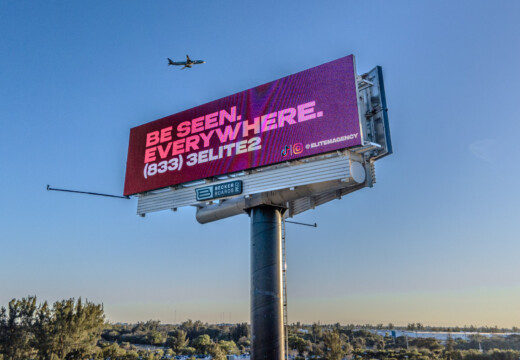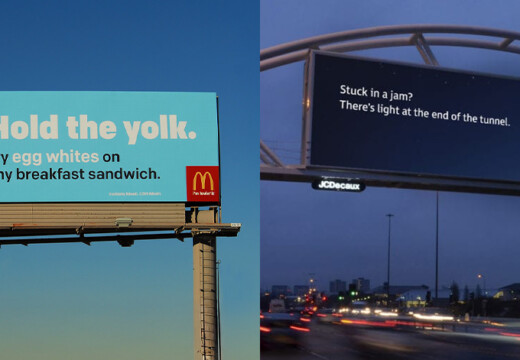Want to know which advertising method works best for your goals? Here’s a quick comparison:
- Digital Billboards: Great for broad, public visibility in specific locations. They’re bold, can’t be skipped, and work well for building brand presence. Costs start at $20/day with pay-per-play pricing.
- Social Media Ads: Perfect for precise audience targeting based on demographics, behaviors, and interests. They drive immediate engagement and offer detailed performance analytics. Costs vary, typically starting at $5–$50/day.
Quick Comparison
| Aspect | Digital Billboards | Social Media Ads |
|---|---|---|
| Primary Focus | Geographic visibility | Individual targeting |
| Audience Reach | Broad exposure in public spaces | Narrow, precise targeting |
| Pricing Model | Pay-per-display (starting at $20/day) | Pay-per-click or impression (varies) |
| Engagement Type | Passive viewing, long-term recall | Active clicks, short-term interaction |
| Performance Tracking | Traffic and visibility metrics | Real-time engagement analytics |
Key takeaway: Use digital billboards for building local awareness and brand authority. Use social media ads for targeted messaging and immediate responses. Combining both often yields the best results.
Social Media Ads Vs. Billboard Ads
Audience Targeting Methods
When it comes to targeting audiences, social media ads and digital billboards take very different approaches. Social media ads use detailed data about demographics, behaviors, and interests to pinpoint specific audience segments, while digital billboards focus on reaching a broad audience in specific geographic locations.
Social Media Targeting Options
Social media platforms are built on a wealth of user data, giving advertisers the tools to target audiences with impressive precision. Here’s how they break it down:
| Targeting Parameter | Description | Impact |
|---|---|---|
| Demographics | Factors like age, gender, income, and education | Helps zero in on specific population groups |
| Behavioral | Tracks purchase history and browsing habits | Targets users based on their actions |
| Interest-based | Hobbies, preferences, and followed topics | Connects with users who are already engaged in relevant content |
| Custom Audiences | Includes email lists and website visitors | Reconnects with people who have already shown interest in your brand |
This level of targeting allows advertisers to tailor their campaigns to the exact audience they want to reach. However, digital billboards take a geographic-first approach to targeting.
Digital Billboard Location Targeting
Digital billboards are all about being in the right place at the right time. Platforms like Blip make it easy for advertisers to choose billboard locations strategically, using data on traffic patterns and audience metrics to maximize visibility.
"Working with Blip has given Mr. Charlie’s the momentum to get our new location on the map while accelerating growth for our original location", says Paul Willey, Owner of Mr. Charlie’s Chicken Fingers.
Key features of digital billboard targeting include:
| Targeting Feature | Capability | Business Impact |
|---|---|---|
| Traffic Analysis | Provides daily impressions data | Ensures ads are seen by as many people as possible |
| Location Selection | Uses an interactive map to choose specific areas | Focuses on neighborhoods or regions that matter most |
| Scheduling Options | Targets specific times of day | Aligns ads with peak traffic periods for maximum impact |
| Performance Metrics | Tracks real-time cost-per-thousand impressions (CPM) | Helps advertisers manage their budgets effectively |
This geographic and time-based approach highlights how digital billboards differ from social media ads.
Targeting Comparison
The contrast between these two methods is clear: social media is about precision, while digital billboards focus on broad exposure within a physical space. Each has its strengths, depending on the campaign goals.
| Aspect | Digital Billboards | Social Media |
|---|---|---|
| Primary Focus | Geographic visibility | Individual targeting |
| Audience Reach | Broad exposure in specific locations | Narrow targeting of specific demographic groups |
| Targeting Basis | Location and traffic patterns | Behavioral and user data |
| Campaign Flexibility | Adjusts by location and schedule | Real-time audience adjustments |
Measuring Reach and Costs
Social Media Performance Data
Social media platforms offer detailed analytics that allow advertisers to track key engagement metrics in real-time. Some of the most important performance indicators include:
| Metric | Description | Average Value |
|---|---|---|
| Reach | The number of unique users who view your content | 1–5% of your follower base organically |
| Impressions | The total number of times your ad is shown | Typically 2–3 times the reach value |
| Engagement Rate | The percentage of users who interact with your content | Industry average: 0.5–3% |
| Click-Through Rate (CTR) | The percentage of viewers who click on your ad | Average: 0.5–1.6% |
These metrics provide a clear picture of how well your social media campaigns are performing. However, costs can fluctuate based on factors like audience targeting and market competition. Let’s now shift focus to how digital billboards track performance using their own set of metrics.
Digital Billboard Performance Data
When it comes to digital billboards, performance is measured through visibility and exposure data. Tools like Blip give advertisers access to traffic reports and impression counts. Their pay-per-play model ensures you only pay for actual ad displays, with campaigns starting as low as $20 per day.
Here are some key metrics used to evaluate digital billboard performance:
| Metric | How It’s Measured | Importance |
|---|---|---|
| Daily Traffic Count | Based on Department of Transportation data | Estimates the size of the potential audience |
| Average Viewing Time | Calculated using speed limits and billboard placement | Indicates how long viewers are exposed to the ad |
| Cost Per Thousand (CPM) | Determined by real-time marketplace rates | Helps optimize ad spend |
| Display Frequency | Tracked through scheduling analytics | Shows how often your ad is displayed to the audience |
Cost and Results Comparison
To make an informed decision, it’s important to compare the cost structures and performance tracking methods of digital billboards and social media ads. Here’s a quick breakdown:
| Factor | Digital Billboards | Social Media |
|---|---|---|
| Initial Investment | Starts at $20/day | Varies, typically $5–50/day minimum |
| Pricing Model | Pay-per-display (pay-per-play) | Pay-per-click or pay-per-impression |
| Reach Potential | Broad exposure in public spaces | Targeted reach to specific audience segments |
| Performance Tracking | Focuses on physical traffic and visibility metrics | Provides detailed analytics on user engagement |
"It’s not a social media thing that you see on your phone. It’s not word-of-mouth. It’s big and bold and out there in public. I would say this is the first step of looking big and public."
- Chris Leslie, Founder of Leslie Lightcraft Co
Digital billboards excel at creating widespread, physical visibility, while social media ads specialize in precise, trackable targeting. Deciding between the two often comes down to your campaign’s specific goals and how you want to allocate your budget.
sbb-itb-2e2e93f
Audience Response and Memory
Social Media User Actions
Social media platforms make it easy for users to interact instantly – whether it’s through likes, shares, comments, or clicks. These actions give brands quick feedback on engagement. But there’s a catch: content on social media often gets lost in the constant flow of posts, limiting how long it stays in a user’s mind. On the other hand, digital billboards stand out because they’re physically present, creating a more lasting impression that can help reinforce brand recall.
Billboard Viewer Response
Digital billboards have a unique advantage: their sheer size and visibility make them hard to ignore. Unlike social media, where interactions can be fleeting, billboards build brand recognition over time through repeated exposure in well-chosen spots. Paul Willey, Owner of Mr. Charlie’s Chicken Fingers, highlights this benefit:
"Working with Blip has given Mr. Charlie’s the momentum to get our new location on the map while accelerating growth for our original location".
This kind of visibility helps brands stay top-of-mind, even after people have left the area where the billboard is displayed.
Response Rate Comparison
When it comes to audience engagement, digital billboards and social media each bring different strengths to the table:
| Aspect | Digital Billboards | Social Media |
|---|---|---|
| Visual Impact | Bold, large-scale presence | Small-screen viewing |
| Brand Authority | Public visibility and credibility | Community interaction |
| Response Type | Passive, long-term recall | Active, short-term engagement |
| Memory Duration | Reinforced through repetition | Limited by fast-moving feeds |
The key difference lies in how these platforms connect with their audiences. Digital billboards rely on their physical presence to create a lasting impression, while social media thrives on quick, interactive moments that are often short-lived. Both play valuable roles, depending on the goals of the campaign.
Conclusion
Main Points Summary
Digital billboards and social media ads each bring their own strengths to the table when it comes to audience targeting and engagement. Social media excels at sparking timely interactions, while digital billboards are ideal for building a lasting brand presence. Thanks to platforms like Blip, billboard advertising has become more accessible, starting at just $20 per day with no long-term commitments.
These unique benefits highlight the importance of choosing the right platform based on your specific marketing objectives, as shown in the guide below.
Platform Selection Guide
Choosing between digital billboards and social media depends on what you’re aiming to achieve with your marketing efforts. Here’s a quick breakdown:
| Goal | Best Platform Choice | Why It Works |
|---|---|---|
| Local Awareness | Digital Billboards | Reaches people directly in key neighborhoods |
| Immediate Response | Social Media | Enables real-time interactions with your audience |
| Brand Authority | Digital Billboards | Increases credibility through public visibility |
| Targeted Messaging | Social Media | Allows precise audience segmentation |
| Cost-Effective Reach | Digital Billboards | Flexible pay-per-play options suit different budgets |
For most businesses, combining both platforms delivers the best results. Digital billboards provide broad, cost-effective exposure and help establish a physical presence in the community. Meanwhile, social media complements this with highly targeted campaigns that drive immediate engagement.
FAQs
What are the differences between digital billboards and social media ads when it comes to audience engagement and memory retention?
When it comes to grabbing attention and making an impression, digital billboards and social media ads shine in their own unique ways.
Digital billboards stand out with bold visuals in high-traffic locations, making them perfect for boosting brand awareness. Their constant presence ensures repeated exposure, which helps messages stick in viewers’ minds. Think of them as the "big, bold statement" in advertising, designed to leave a lasting mark.
On the flip side, social media ads focus on interaction and precision. They allow businesses to target specific audiences based on factors like age, interests, and online behavior. These ads are great for sparking immediate actions, such as clicks or purchases, but their impact can fade quickly because of the fast-moving nature of social media platforms.
Ultimately, the choice between these two depends on your campaign goals. If you’re looking to create broad visibility, digital billboards are the way to go. But if you want to connect with individuals and drive quick actions, social media ads are your best bet.
How can businesses decide between using digital billboards or social media ads to reach their target audience?
When choosing between digital billboards and social media ads, it’s essential to weigh factors like your target audience, campaign objectives, and budget. Digital billboards shine when it comes to reaching a broad audience in busy, high-traffic locations. They’re a fantastic option for boosting brand recognition or promoting local events to a wide audience. On the other hand, social media ads excel at pinpointing specific groups, thanks to their ability to target users based on demographics, interests, and behaviors – ideal for engaging niche audiences or driving online interactions.
For businesses looking for a cost-effective way to explore outdoor advertising, digital billboard networks offer a flexible solution. With campaigns starting at just $20 per day, you can test the waters without committing to lengthy contracts. In the end, the decision boils down to your campaign’s focus: do you need broad exposure or precise audience targeting?
How can combining digital billboards with social media ads improve a marketing strategy?
Combining digital billboards with social media ads creates a dynamic, multi-channel marketing strategy that taps into the strengths of both platforms. Digital billboards are perfect for grabbing attention in high-traffic areas, showcasing bold, visually appealing messages to a wide and varied audience. Meanwhile, social media ads shine by delivering highly targeted campaigns tailored to specific demographics, interests, and behaviors.
Together, these tools can amplify your message across multiple touchpoints. Picture this: a digital billboard catches someone’s eye during their daily commute, and later, a social media ad follows up with more details or a clear call-to-action. This seamless integration not only boosts brand recognition but also enhances engagement and drives conversions by connecting with people both offline and online.
Related posts
- 5 Ways Small Businesses Can Leverage Digital Billboards
- 7 Factors for Choosing Billboard Locations
- How Digital Billboards Boost Local Engagement
When it comes to grabbing attention and making an impression, digital billboards and social media ads shine in their own unique ways.
Digital billboards stand out with bold visuals in high-traffic locations, making them perfect for boosting brand awareness. Their constant presence ensures repeated exposure, which helps messages stick in viewers' minds. Think of them as the "big, bold statement" in advertising, designed to leave a lasting mark.
On the flip side, social media ads focus on interaction and precision. They allow businesses to target specific audiences based on factors like age, interests, and online behavior. These ads are great for sparking immediate actions, such as clicks or purchases, but their impact can fade quickly because of the fast-moving nature of social media platforms.
Ultimately, the choice between these two depends on your campaign goals. If you’re looking to create broad visibility, digital billboards are the way to go. But if you want to connect with individuals and drive quick actions, social media ads are your best bet.
"}},{"@type":"Question","name":"How can businesses decide between using digital billboards or social media ads to reach their target audience?","acceptedAnswer":{"@type":"Answer","text":"
When choosing between digital billboards and social media ads, it’s essential to weigh factors like your target audience, campaign objectives, and budget. Digital billboards shine when it comes to reaching a broad audience in busy, high-traffic locations. They’re a fantastic option for boosting brand recognition or promoting local events to a wide audience. On the other hand, social media ads excel at pinpointing specific groups, thanks to their ability to target users based on demographics, interests, and behaviors - ideal for engaging niche audiences or driving online interactions.
For businesses looking for a cost-effective way to explore outdoor advertising, digital billboard networks offer a flexible solution. With campaigns starting at just $20 per day, you can test the waters without committing to lengthy contracts. In the end, the decision boils down to your campaign’s focus: do you need broad exposure or precise audience targeting?
"}},{"@type":"Question","name":"How can combining digital billboards with social media ads improve a marketing strategy?","acceptedAnswer":{"@type":"Answer","text":"
Combining digital billboards with social media ads creates a dynamic, multi-channel marketing strategy that taps into the strengths of both platforms. Digital billboards are perfect for grabbing attention in high-traffic areas, showcasing bold, visually appealing messages to a wide and varied audience. Meanwhile, social media ads shine by delivering highly targeted campaigns tailored to specific demographics, interests, and behaviors.
Together, these tools can amplify your message across multiple touchpoints. Picture this: a digital billboard catches someone's eye during their daily commute, and later, a social media ad follows up with more details or a clear call-to-action. This seamless integration not only boosts brand recognition but also enhances engagement and drives conversions by connecting with people both offline and online.
"}}]}


